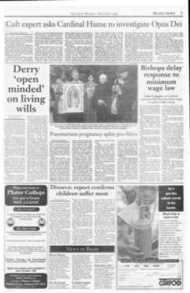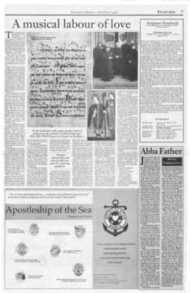Page 6, 26th June 1998
Page 6

Report an error
Noticed an error on this page?If you've noticed an error in this article please click here to report it.
Tags
Share
Related articles
Why Did So Many Victorian Decadents Become Catholics?
Prejudice Against The Convert
An Uphill Fight To Aid Poor
How Clifton Saw The Light
Holy Writ
Happiness in Hell?
RUSSELL SPARKES on a mixed bunch of converts
A Victorian Convert Quintet by Michael Clifton, Saint Austin Press, £9.95 MANY Hone are probably vaguely aware of the "second spring" of English Catholicism: that is, the flood of distinguished converts from Anglicanism which revitalised the Church in the second half of the nineteenth century. The stories of giants such as Newman and Manning are well known, but there is less awareness and understanding of more ordinary people who followed Newman's journey of faith. In A Victorian Convert Quintet, Fr Michael Clifton describes five such people, all closely involved with Newman and the Oxford Movement.
Some of the stories are inspiring, almost heroic, and show the great contributions some of these converts made to rebuilding the Church in England. Robert Coffin was a man of quiet but profound spirituality who led the Redemptorist mission to England, reluctantly ending up third Bishop of Southwark. The ultramontane Bishop Coffin became confessor, friend, and confidant to Cardinal Manning, who regularly sought his advice. Perhaps the most attractive personality was Frederick Oakeley, a gifted musician who loved the Anglican rite and the intellectual life of Oxford, but who gave it all up to become Catholic priest of a large and poor parish in Islington.
However, some of the converts caused much grief. For example, the book describes the tragi-comedy of Richard Sibthorp, an Anglican clergyman who converted to Rome and became a priest, before going back to the Church of England. When Cardinal Wiseman heard this news, he took to his bed with shock. Years later Sibthorp read the story of the Cure d'Ars and decided to become a Catholic again, and was re-instated as a priest. When he died, he was given a Requiem Mass at Nottingham Cathedral, followed by a Church of England burial service at Lincoln l Fr Clifton gives his story the fitting title of "Looking Both Ways at Once".
Some of the converts also do not seem to have genuinely acknowledged the concept of dogma or the teaching authority of the naagisterium, such as the "Liberal Catholic" Richard Simpson, and most notably, in the strange story of a professor of anatomy, St George Jackson Mivart.
The author rightly describes Mivart as a postmodernist, and Mivart's casual dismissal of Catholic dogma would be described as "advanced" even today. "Many modern Catholics," he wrote, "have repudiated the doctrine of atonement and regard Christ's life and death as merely a great object lesson... if Christ's body had rotted in the grave, the truth of the resurrection would not in the least be affected." He also wrote a number of pamphlets on a bizarre heresy entitled "Happiness in Hell". This idea, that lost souls might be given time off as a respite, had been mentioned by some of the early Fathers but dismissed as against catholic teaching which Mivart deliberately chose to ignore. The theologian commissioned to study this wrote: "The fear of hell is a powerful deterrent to many educated as well as uneducated people ... For this reason I cannot help regarding Professor Mivart's teaching as very mischievous as well as false".
0 f course, none of this was acceptable in the nineteenth century, and it is not surprising that Mivart ended up being excommunicated by Cardinal Vaughan in 1900. Shortly afterwards he died, suddenly, and was of course buried in unconsecrated ground. However, his family successfully petitioned Archbishop Bourne to allow his reburial in consecrated ground on the grounds that his later writings were symptoms of senile decay, and he was re-interred in Kensal Green in 1904.
The book is written in a light, chatty style and is by no means academic or heavy in tone. It gives an enjoyable insight into an almost forgotten era.
blog comments powered by Disqus











